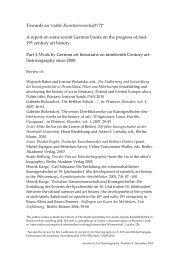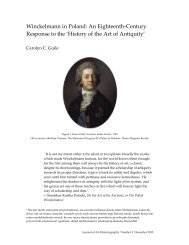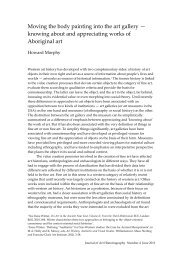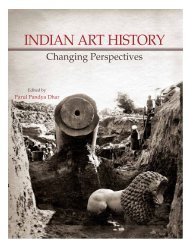The advantages and disadvantages of Art History to Life: Alois Riegl ...
The advantages and disadvantages of Art History to Life: Alois Riegl ...
The advantages and disadvantages of Art History to Life: Alois Riegl ...
You also want an ePaper? Increase the reach of your titles
YUMPU automatically turns print PDFs into web optimized ePapers that Google loves.
new style. For <strong>Riegl</strong>, this would be the best way for the Museum <strong>to</strong> proceed in the<br />
future. 34 This was al<strong>to</strong>gether different from political or commercial attempts <strong>to</strong><br />
popularize an his<strong>to</strong>rical style by making it fashionable.<br />
This was a surprising argument from a man who was both an art his<strong>to</strong>ry<br />
pr<strong>of</strong>essor <strong>and</strong> a cura<strong>to</strong>r at the Museum for <strong>Art</strong> <strong>and</strong> Industry. Not only did he reject<br />
his<strong>to</strong>ricism he also criticized the excesses <strong>of</strong> scholarly culture for its abuses <strong>of</strong> power.<br />
Scholarship <strong>and</strong> the urge for accuracy had robbed artists <strong>of</strong> their confidence <strong>and</strong><br />
prevented the emergence <strong>of</strong> a new art. <strong>The</strong> result was unfruitfulness <strong>and</strong> stagnation.<br />
‘Über Renaissance der Kunst’ documents <strong>Riegl</strong>’s ongoing intellectual debt <strong>to</strong> the<br />
early Nietzsche, but while <strong>Riegl</strong> adopted a Nietzschean critique <strong>of</strong> art his<strong>to</strong>ry, but he did<br />
not suggest that art his<strong>to</strong>ry should be ab<strong>and</strong>oned al<strong>to</strong>gether. As in Stilfragen, <strong>Riegl</strong>’s real<br />
opponent was scholarly excess. Like Nietzsche, he wanted <strong>to</strong> res<strong>to</strong>re a balance <strong>to</strong> the<br />
relationship between the past <strong>and</strong> present. In addition, he hoped <strong>to</strong> redirect the<br />
Museum in<strong>to</strong> channels that would focus more on collection <strong>and</strong> scholarship—but the<br />
right kind <strong>of</strong> scholarship; not the prescriptive tyranny <strong>of</strong> the art his<strong>to</strong>rian but the loving<br />
care for documents <strong>of</strong> the human past. Nevertheless, <strong>Riegl</strong>’s argument - the tyranny <strong>of</strong><br />
art his<strong>to</strong>ry created the sterility <strong>of</strong> the nineteenth century - was a remarkable position for<br />
a practicing art his<strong>to</strong>rian at the most prestigious arts <strong>and</strong> crafts museum on the<br />
continent. Yet he was willing <strong>to</strong> challenge the Museum for the sake <strong>of</strong> truthfulness.<br />
It was likely that this had pr<strong>of</strong>essional consequences. As he wrote this essay in<br />
1894, <strong>Riegl</strong> was hoping for a promotion at the Museum that reflected his new stature at<br />
the University <strong>of</strong> Vienna, where he had recently been appointed full pr<strong>of</strong>essor <strong>of</strong> <strong>Art</strong><br />
<strong>His<strong>to</strong>ry</strong>. This was doubly important for his career at the Museum had not moved<br />
forward; after seven years, he was still only an adjunct cura<strong>to</strong>r <strong>of</strong> textiles. But a<br />
promotion <strong>to</strong> full cura<strong>to</strong>rship did not happen. In a bitter series <strong>of</strong> letters <strong>to</strong> the<br />
archaeologist Ot<strong>to</strong> Benndorf, <strong>Riegl</strong> complained about his situation, which worsened<br />
with each passing year. 35 In the same way, <strong>Riegl</strong>’s contribution <strong>to</strong> the his<strong>to</strong>ricism debate<br />
fell on deaf ears, at least inside the Museum, where its leaders continued devising plans<br />
<strong>to</strong> rehabilitate another his<strong>to</strong>rical style, the Biedermeier, in an upcoming exhibition. 36<br />
Perhaps because <strong>of</strong> its his<strong>to</strong>rical context, <strong>Riegl</strong>’s essay on the Renaissance<br />
problem continued <strong>to</strong> be neglected in the twentieth century. Until now, it has not been<br />
considered as significant <strong>to</strong> his theoretical work. Yet this is a significant loss <strong>to</strong> our<br />
underst<strong>and</strong>ing <strong>of</strong> <strong>Riegl</strong>’s career path <strong>and</strong> his relationship <strong>to</strong> the Museum for <strong>Art</strong> <strong>and</strong><br />
Industry. His assertion that a style would appear when everyone ‘least expected it’ must<br />
have seemed outrageous <strong>to</strong> men like Falke <strong>and</strong> Bucher, who viewed the creation <strong>of</strong> a<br />
new style as the certain <strong>and</strong> rational outcome <strong>of</strong> their activities. When re-reading <strong>Riegl</strong><br />
from this perspective it is possible <strong>to</strong> see how, starting with his earliest essays on<br />
Oriental rugs, <strong>to</strong> Stilfragen, through his book on the folk arts (Volkskunst, Hausfleiß und<br />
34 <strong>Riegl</strong> elaborated on this in a proposal <strong>to</strong> the Ministry <strong>of</strong> Religions <strong>and</strong> Education in 1900. See n. 29.<br />
35 Several letters from <strong>Riegl</strong> <strong>to</strong> Benndorf, beginning in 1889, are located in the Austrian National Library;<br />
ÖNB, Nachlaß Benndorf, H<strong>and</strong>schriften Abteilung H 82/54.<br />
36This was the Vienna Congress Exhibition <strong>of</strong> 1896. See, Katalog der Wiener Congress Ausstellung (Vienna:<br />
<strong>Art</strong>aria, 1898).<br />
12
















